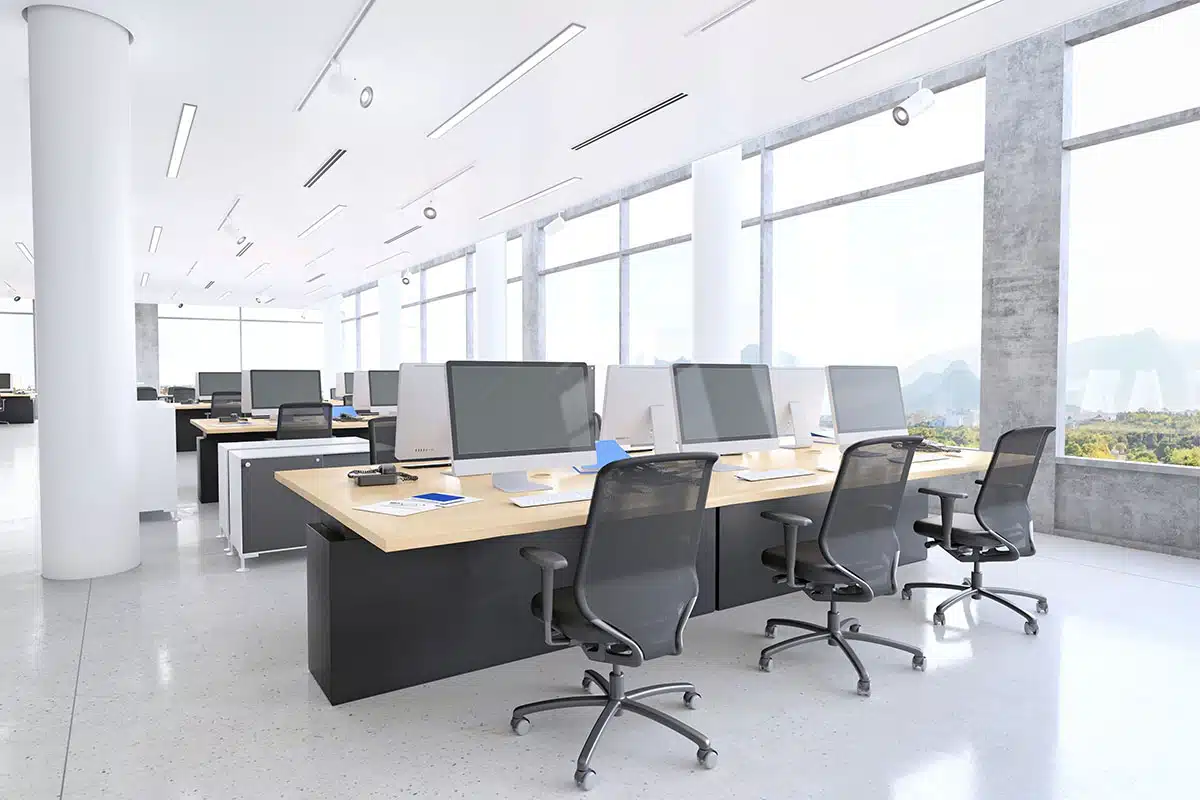It may be gradual, but it is happening. Organizations are implementing return to office (RTO) policies that ask employees to be in the office at least a few days a week.
After the COVID-19 era of fully remote work led to downsizing and vacancies in the commercial office space, emerging RTO policies are now causing work schedules to shift again. While it’s true that many businesses have embraced remote work schedules, most companies now require employees to be in the office for at least part of the week. Only 4% of companies say they expect to remain fully remote in the future.
But while workers are coming into the office more often than before, it’s not like companies have rolled back the clock to the pre-pandemic era. Heightened employee expectations, along with a labor shortage that makes hiring and retention a priority, mean that facilities management teams need to be more flexible than ever before.
Smart facility executives and property managers are taking note of changed expectations and are working with company leadership to ensure building services and amenities are conducive to an office environment that “earns the commute”—whether employees are in the office two days a week or five.
Heightened employee expectations, along with a labor shortage that makes hiring and retention a priority, mean that facilities management teams need to be more flexible than ever before.
With that in mind, we look at three ways that facility managers and property owners can keep employees and tenants happy as companies implement or expand their RTO policies.
Hoteling, Hot Desking, and the Hybrid Schedule
Most companies understand that return to office policies will be most successful when a carrot and not a stick is used to get valued employees back in the office. And the carrot for many employees these days is a hybrid work schedule. This is why, according to CBRE Global Workplace & Occupancy Insights, less than 10% of organizations require employees to be in the office five days a week.
While some companies have tried to mandate that their employees return to the office five days a week, this policy has mostly backfired. Businesses that offer hybrid office schedules are able to fill jobs twice as fast as those who require full-time attendance, according to Fortune magazine, making it clear that the hybrid workplace is here to stay. That explains why the CBRE study found that 90% of RTO policies offer a hybrid option.
And while some CEOs grumble about hybrid work schedules, the fact is that companies can realize significant savings by embracing this model. It costs about $8,000 to maintain an office desk. If adopting a hybrid schedule enables a company to move from a one-to-one worker-to-desk ratio to a two-to-one ratio, that can translate into significant savings. For this reason, savvy organizations are introducing desk hoteling, a system in which workers reserve a desk ahead of time through desk booking software or a mobile app. Another popular option is hot desking, where employees grab a desk on a first-come, first-serve basis when they arrive in the office.
To accommodate desk-sharing workspaces and create an efficient hybrid return to office transition, facility leaders need to consider changes on several fronts.
Create Equal Spaces
Is hot desking revealing that certain desks in your office are constantly occupied, while others are consistently empty? To ensure that workers aren’t battling for the same few desks while others are left underutilized, facility managers should investigate the reasons some workstations are shunned. Is the desk in a Wi-Fi dead spot? Is there insufficient light? A lack of electrical outlets?
And there’s another consideration that has nothing to do with the workstation itself. The real estate maxim—“location, location, location”—applies to desks as much as houses. A third of workers report that their incentive to come into the office is to be around coworkers. Given that preference, it’s clear that outlying desks are going to be ignored in favor of workstations that are located in the center of the action. Facilities managers can respond to this preference by placing workstations in grouped configurations.

Leverage IoT
To reduce energy consumption, use IoT-enabled building automation systems to monitor and control energy use. This smart technology can optimize energy consumption by adjusting cooling systems, turning off lights, or automatically closing blinds against direct sunlight. As the fixed workday disappears, take advantage of the data gathering and analytical capabilities of automated systems to optimize how space is used. Statistics from desk booking apps can show desk occupancy, and occupancy sensors can reveal room utilization in communal areas. This data can then be used to make decisions about space allocation, improve occupant comfort, and control building costs as work schedules fluctuate.
Optimize Wireless Technology
Seamless wireless connections are vital for productive in-office work. Remote work has increased the use of technology for meetings and presentations, and this will remain as workers return to offices. Having excellent wireless presentation capabilities, interactive whiteboards in meeting rooms, and similar productivity-enhancing technology will make it easy for those workers who are in the office to collaborate with those who aren’t—a necessity with hybrid work. And for those workers who are in the office on any given day, smart switches and fixtures that control lighting intensity and color can facilitate greater productivity, and go a long way in keeping employees and tenants happy.
Updating Spaces for the Hybrid Worker
Organizations are reevaluating the quality of office environments, and many are finding that improved amenities and more welcoming spaces are a good way to entice employees to make the commute to the office. Now may be time for the tiny chair-less kitchen or drab windowless lunchroom to be transformed into a more inviting space. In addition to rearranging office spaces and creating flexible seating arrangements that align with hybrid work schedules, adding or upgrading amenities is another way to keep employees happy and productive.
Provide Options
Comfortable communal spaces with soft furnishings are great as collaboration hubs for impromptu meetings or brainstorming sessions, and can even lead to better teamwork and morale. At the same time, many employees report the need for quiet in order to focus, which is why it’s equally important to provide rooms or booths that are at least partially soundproofed.
Use Natural Light
Natural light has been shown to improve well-being among employees. It’s also a great way to reduce energy consumption. If your facility doesn’t already have daylight sensors, consider installing them. Reducing or eliminating artificial lighting whenever natural light is available can introduce significant cost savings—and make the workplace ambiance more inviting. In areas where less natural light is available, consider alternative lighting options such as focused task lighting or softer ambient lighting, instead of banks of unforgiving fluorescent lights as the sole source of illumination.

Cosmetic improvements
Just because an upgrade is easy or inexpensive doesn’t mean it’s not effective. A coat of paint, plenty of plants, and new decor in dull areas can make a big difference to the office ambience. This goes for hallways and bathrooms too.
Service Amenities
Employee surveys show that workers appreciate amenities like gyms, cafés, outdoor trails, and roof gardens. But not every company can afford a café on the roof or a fully outfitted gym. In that case, consider smaller, less expensive improvements, like upgrading the seating in an outdoor patio. Even little changes can make a difference.
Customer Service for the Return to Office Naysayers
While many executives want to bring employees back to the office five days a week, a high percentage of employees do not share that sentiment. In fact, according to Forbes Advisor, 98% of workers want to work remotely for at least part of the week.
The reasons for this preference vary. Some employees do not want to return to the office because their WFH (work-from-home) setup is better. Many have caregiving responsibilities that require flexible schedules. Some employees are simply more productive, and more likely to work longer hours, when at home. Others have concerns about viral exposure.
These are all valid concerns, and they can be addressed by providing excellent facility management services.
Responsiveness
Workers are not willing to make the commute to a building where the thermostat is broken or there are unresolved plumbing issues in one of the bathrooms. Here’s where CMMS software can make a real difference, enabling you to stay on top of these inevitable issues in a timely manner. These software systems also make it possible to engage in predictive maintenance, so that you catch issues before they happen.
Show Off Your Cleaning
Buildings with efficient and timely janitorial protocols will make employees feel less stressed. Consider scheduling some janitorial services during work hours. This will not only save on labor costs, but will also reassure building occupants that high standards of cleanliness are being met. Making janitorial staff visible during the workday has been shown to reduce employee complaints, perhaps because it provides visual proof that the building is being properly maintained.
Even though the pandemic is over, COVID-19 and other viruses are still circulating. Letting employees know that sanitation protocols are still in effect, and letting them see for themselves that these protocols are being carried out by the janitorial staff, can go a long way in providing peace of mind.
Facilitate Communication and Community
Incorporating digital signage to show who is in the office and where they are working can be a great way to increase community among employees. And always be sure to communicate to occupants when significant maintenance is being performed, so that they know what to expect in advance. For significant projects, communicate well in advance—through email and physical signage—so that building occupants can plan for any disruptions to their routines.
Facility Managers Can Ease the Return to Office
Office schedules and leasing may have been upturned due to the pandemic, but the RTO trend is continuing to bring workers back to the office—albeit a different kind of workplace.
New office configurations and technology will be crucial for meeting the demands of hybrid work schedules, as will agile facility services that emphasize excellent customer service. By working cross-functionally with company leadership, facility managers can play a key role in creating a workplace that runs smoothly and makes employees happy to be back in the office.
